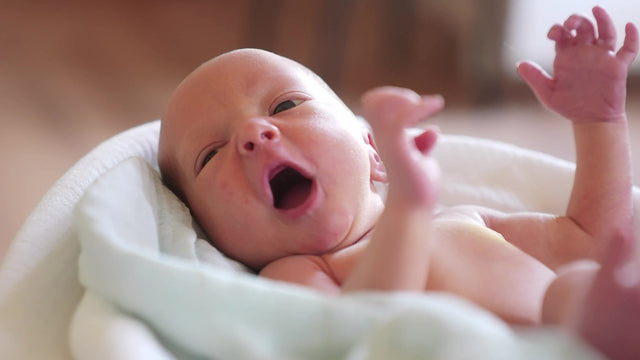What Is the Moro Reflex?

On This Page
Have you ever noticed that as you’re setting your precious baby down to bed their body suddenly tenses, they jut out their arms, and their eyes go wide as if they’d just been majorly spooked? This fright-like reaction is known as the Moro reflex (also aptly called the “startle reflex”). The Moro reflex is one of several automatic and involuntary reactions babies are born with. These newborn reflexes are designed to help get babies through the first few months of life before they start to learn the ropes of being a tiny human! Why exactly are baby’s armed with the Moro reflex—and what does it do? Here, all your Moro reflex questions—answered!
What is the Moro reflex in babies?
The Moro reflex (aka newborn startle reflex) is a protective reaction to either a sudden movement or a loud sound. This newborn reflex is marked by your baby giving you a startled look, possible tears, and dramatically extending their neck, legs, and arms, with palms up and thumbs flexed. But when you react by supporting your baby’s head, they’ll quickly flex their elbows, relax, and bring their arms together in a big hug.
In all likelihood, the Moro reflex is a leftover survival response from the cave-baby days, which helped always-carried little ones cling to their parent for safety. In fact, Dr. Harvey Karp jokes that the Moro reflex has probably “saved countless baby monkeys whose moms were able to catch their out-stretched arms as they started to fall.”
What triggers the Moro reflex?
While various sudden movements or loud noises may activate the Moro reflex, it’s often set off when your baby’s head abruptly shifts position or tips backward, making your little one think that they’re falling. You may notice your sweet baby’s startle reflex is elicited when you try to lower them into the bassinet. Your little one’s instinctive reaction causes them to wake up and shoot their arms open, as if they’re trying to grab hold of you.
Moro Reflex: How Swaddling Can Help
There’s no way to un-teach the Moro reflex, but if you swaddle your baby before laying them down in their bassinet or crib, you can dampen the startle response, making sleepytime so much easier! Because swaddling, an integral part of the 5 S’s for soothing babies, recreates the snug hug of the womb, it decreases startling and helps to activate your baby’s calming reflex, aka their “off switch” for fussing and “on switch” for sleep. Plus, arms-down swaddling keeps your baby’s flailing arms under wraps so that they cannot accidentally bonk themselves awake. If you’re struggling to get your infant to sleep in the bassinet, the Moro reflex and a poor swaddle may be to blame. For a safe, secure, and lightning-fast swaddle every time, try the award-winning Sleepea 5-Second Swaddle. Sleepea’s patented inner flaps and easy-slide two-way zipper keeps even the squirmiest of would-be escape artists snugly wrapped all sleep long.
Moro Reflex: How White Noise Can Help
Much like swaddling, white noise can help quell your baby’s sleep-disrupting Moro reflex. Remember, loud or surprising noises can activate your little one’s startle reflex, but white noise creates a “blanket of sound,” which masks outside disturbances, like a loud truck passing by. Bonus: The consistent staticky din of white noise mimics the comforting sounds of the womb, activating your baby’s calming reflex…just like swaddling. Swaddling and Shushing, aka white noise, are both part of the 5 S’s—and both are scientifically proven to help little one’s sleep. (Read about the research-backed success of the 5 S’s and Dr. Karp’s award-winning white noise machines.)
How long does the Moro reflex last?
Your baby’s Moro reflex can be seen in utero between 25 and 30 weeks, which means full-term babies arrive already equipped. While the startle reflex usually peaks during the first month, don’t get too used to it! It’ll start to gradually disappear by the time your baby is 12 weeks old. And it should be completely gone by 6 months.
What does it mean if Baby doesn’t have a Moro reflex?
The Moro reflex can sometimes be weak or even absent in premature babies, especially if they’re born before 25 weeks, when the startle reflex first starts to develop in some. Preemies tend to have lower muscle tone, which makes it more difficult to have a strong Moro reflex, notes research in the Journal of Clinical Medicine Research.
It’s important to note that the Moro reflex should be present equally on both sides of your baby’s body. The absence of the Moro reflex on one side could mean your little one has a wounded shoulder or they’ve experienced an injury to the brachial plexus, which are the cluster of nerves running from the lower neck and upper shoulder area into the arm. If your baby has no startle reflex, your healthcare provider may suggest screening for possible brain or spinal cord injury, infection, and/or muscle weakness.
What happens if the Moro reflex doesn’t go away?
If your baby’s Moro reflex is still in play at 6 months, reach out to your child’s healthcare provider. They may advise screening your child for spastic cerebral palsy.
More on Newborns
- This Is How Much Your Newborn Should Sleep
- All About the Fourth Trimester
- What's the Rooting Reflex?
- Is My Newborn's Poop Normal?
- Newborn Screenings Need-to-Know
- What Should a Newborn Sleep In?
REFERENCES
- American Academy of Pediatrics (AAP): Newborn Reflexes
- Cleveland Clinic: Newborn Reflexes
- National Library of Medicine, StatPearls: Moro Reflex
- Assessment of Primitive Reflexes in High-risk Newborns. Journal of Clinical Medicine Research. November 2011
- Mount Sinai: Moro reflex